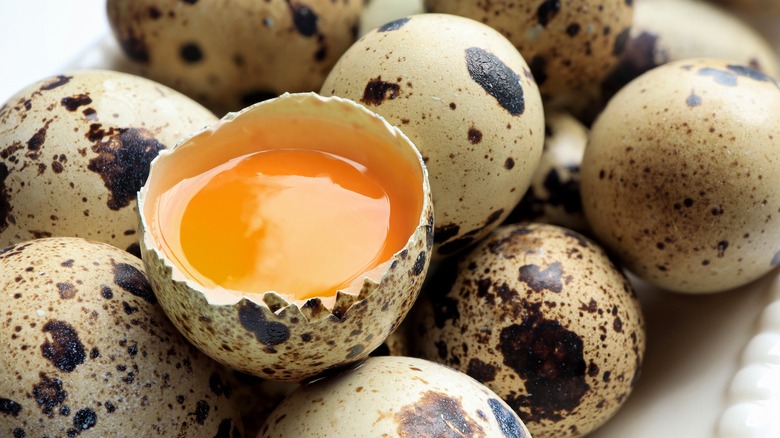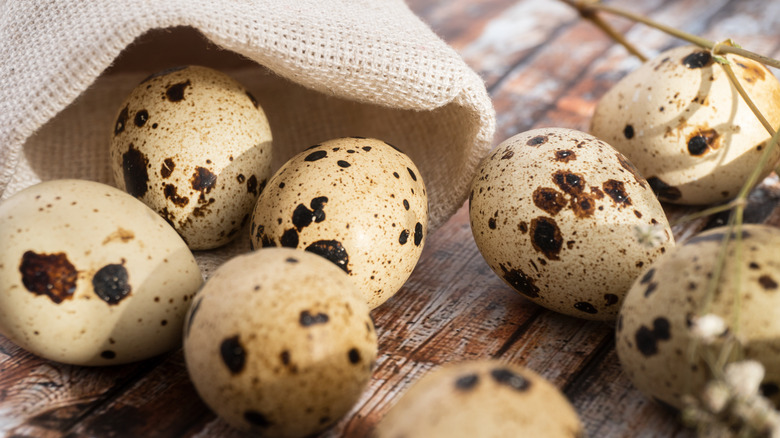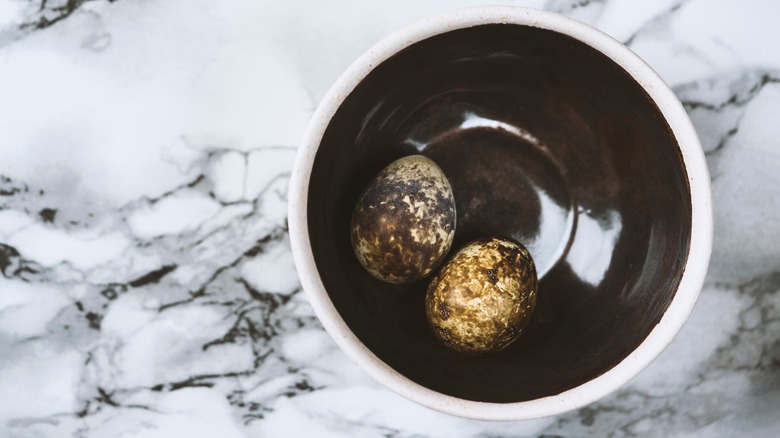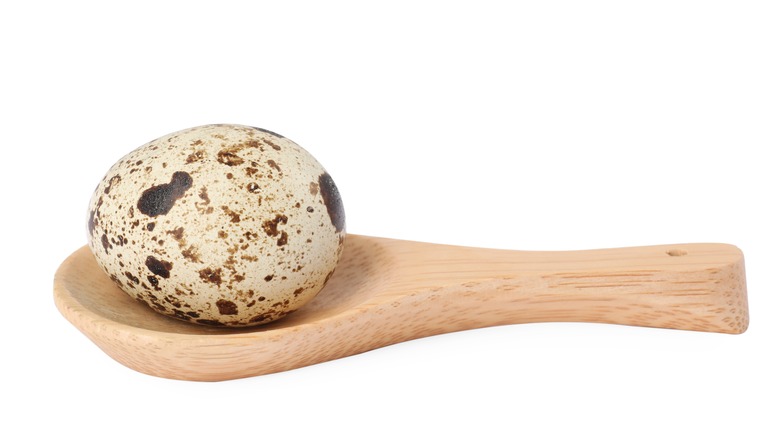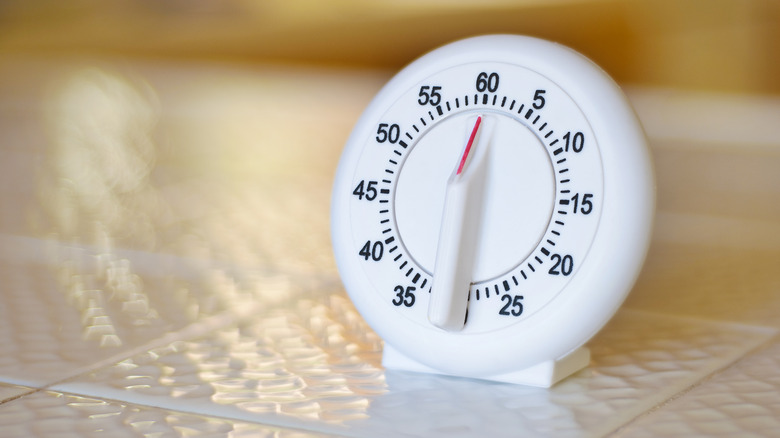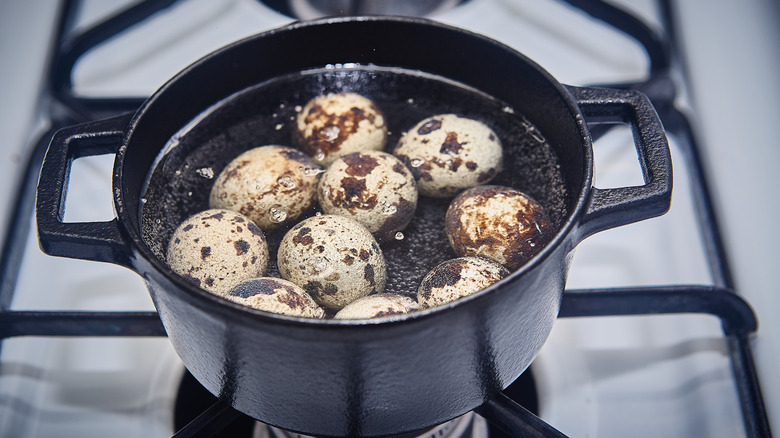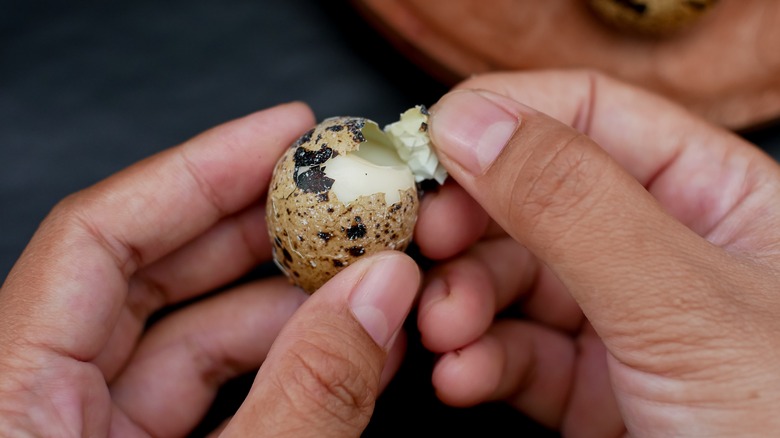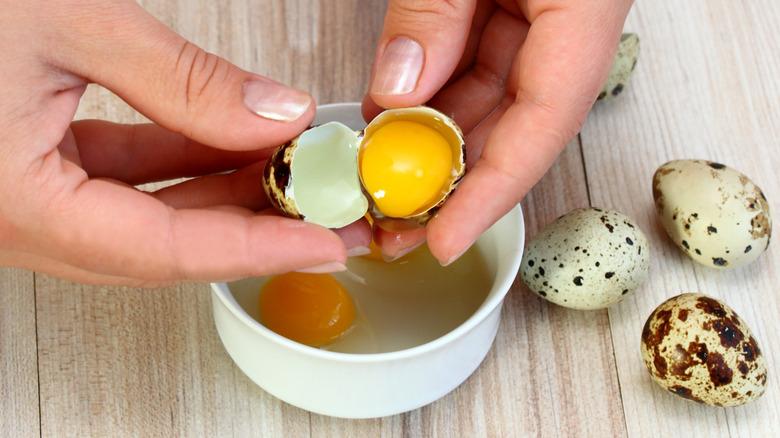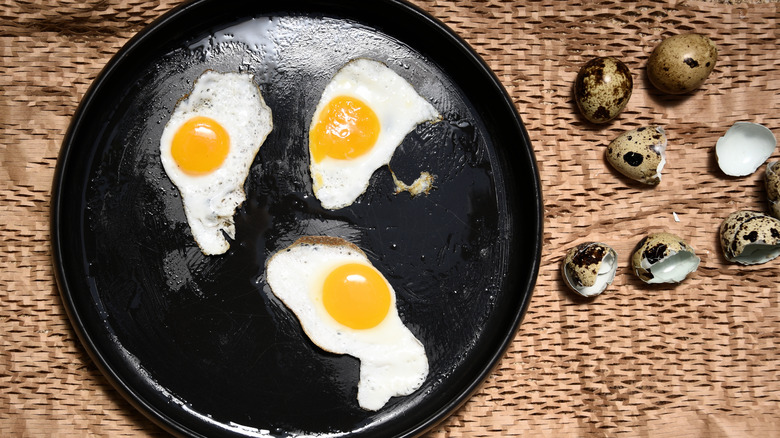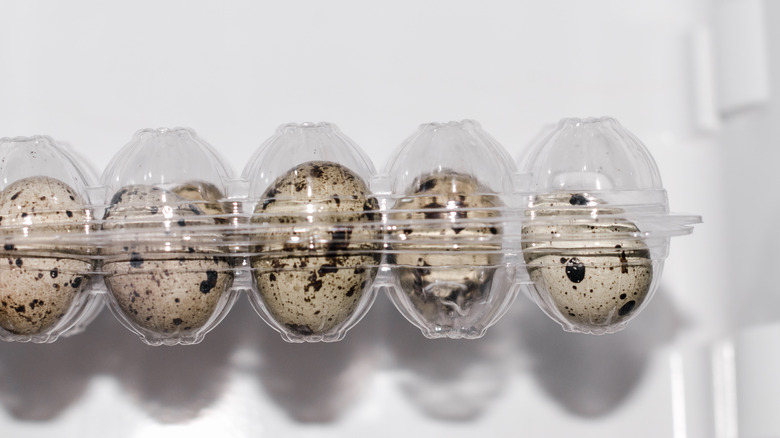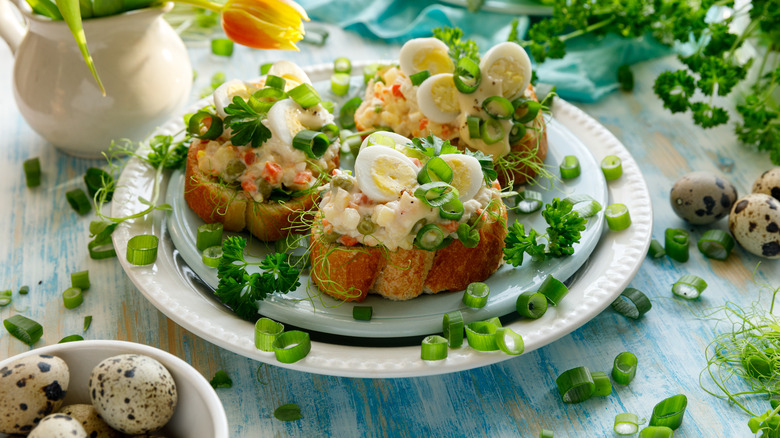10 Essential Tips For Cooking Quail Eggs
Cooking with quail eggs is a surefire way to level up your cooking. Once considered a delicacy reserved for the plates of diners at high-end restaurants, these bite-sized eggs are experiencing a rise in popularity as more people discover their delectable flavor and health benefits.
Quail eggs are produced by a small game bird from the pheasant family that grows to only 4 to 8 inches in length, which explains why the eggs are so deliciously tiny. The eggs are surprisingly rich in vitamins and nutrients, containing vitamin B12, iron, and riboflavin. You can find them in most larger grocery stores and local farmer's markets.
Their small size and beautifully speckled shells add whimsy to any dish; despite their size, they are full of flavor far richer than regular chicken eggs. Quail eggs are quick and easy to cook with the right tools and a little know-how. Here are tips to get you started.
Test for freshness
It's important to make sure your quail eggs are fresh before cooking with them. Be sure to check the shells closely for any cracks or damage. A cracked shell makes it easy for bacteria to penetrate the egg and causes them to spoil quickly, making them unfit for cooking. Unlike chicken eggs, quail egg shells have an invisible protective coating called bloom that helps keep pathogens at bay. The bloom is removed when the eggs are washed, so it's vital that you check quail eggs for damage once you rinse them.
You can check the freshness of your quail eggs by gently placing them in a bowl of room-temperature water. Any eggs past their prime will float to the top of the water while the fresh eggs will settle at the bottom. Throw away any eggs that float. You should also discard any eggs that smell bad.
Bring eggs to room temperature
Boiling quail eggs is one delicious and simple way to prepare them. Set yourself up for success by bringing the quail eggs to room temperature before you cook them. The eggs' shells are highly fragile, and the drastic change in temperature from the fridge to boiling water can cause the shells to crack.
There are two steps you can take to prevent this. You can gently bring the eggs to room temperature by taking them out of the fridge and letting them sit on the counter for 30 to 45 minutes before using them. If you're short on time, use a slotted spoon to carefully place the quail eggs in a bowl of warm water. This will gently raise the temperature of the eggs so there's less of a shock when you add them to the boiling water. Make sure the water is warm and not hot. Hot water will start to cook the eggs.
Choose the right tools
Cooking quail eggs is a breeze when you use the right tools. If you're boiling your eggs, choose a shallow pan instead of a deep pot. The water will boil faster, and the eggs are less likely to crack when placed into the pan. Use a slotted spoon to gently place the quail eggs in the boiling water. Dropping them in by hand may cause the eggs to hit the bottom of the pan and break.
If you're frying quail eggs, consider buying a pair of quail egg scissors. They're made specifically to remove the tops of quail eggs without breaking the shell. You can also use a paring knife or a small serrated knife to open the eggs. Choose a nonstick pan and a little olive oil or butter to prevent the eggs from sticking. Whether boiling or frying your eggs, use a timer to ensure you don't overcook them.
Mind the time
Timing is important when cooking quail eggs. Their small size translates to a shorter cooking time than standard chicken eggs no matter which cooking method you use. The eggs have a thin, fragile shell that allows them to boil quickly, in a fraction of the time required for larger eggs, and frying these bite-sized beauties is just as fast. Whether boiling or frying your eggs, use a timer to ensure you don't overcook them.
To boil quail eggs, bring a shallow pan of water to a boil. You won't need as much water as a regular egg, just enough to cover the quail eggs. Use a spoon to gently lower the eggs into the boiling water. Set your timer for two minutes for soft-boiled eggs. Medium-boiled eggs will need three minutes, and hard-boiled quail eggs will take three ½ to four minutes. Frying quail eggs will take one to two minutes.
Shock after boiling
When eggs are boiled, the heat that builds inside them doesn't stop as soon as you remove them from the heat source. Temperatures can continue to rise even after you stop cooking them. This carryover cooking makes it easy to overcook your eggs. You can prevent carryover cooking and lower the temperature of the quail eggs by shocking the eggs. Shocking is a culinary term that refers to the process of transferring foods cooked in hot water to a bowl of ice-cold water.
To boil quail eggs, bring a shallow pan of water to a boil. You won't need as much water as a regular egg, just enough to cover the quail eggs. Use a spoon to gently lower the eggs into the boiling water. Cook for two minutes for soft-boiled eggs, three minutes for medium-boiled eggs, and three ½ minutes for hard-boiled quail eggs. Remove the boiled eggs from the hot water and immediately place them in a bowl of ice water. This shock will cool the eggs down, preventing them from overcooking. Let the eggs sit in the water until they are cool enough to touch before peeling them.
Peel the eggs carefully
Quail eggs' small size and fragile shell make peeling them tricky. The process is similar to peeling a regular chicken egg, but it's essential to be gentle to keep from smashing the eggs.
After you've shocked the boiled quail eggs in a bowl of ice water, carefully pat them dry. Wet eggs can be slippery. Gently tap one end of the egg on the counter or the edge of a small bowl. You can also use a spoon to crack quail eggs by lightly tapping the edge of the spoon against the shell at one end. Place the cracked egg on the counter or other flat surface and roll it back and forth under your hand, applying gentle pressure to break the rest of the shell. Proceed with caution and use less pressure than you would with a chicken egg so you don't crush the quail egg. Once the surface of the shell is cracked all over, use your fingers to peel the shell and the membrane underneath away from the egg.
If the eggs are difficult to peel, it's likely because they're fresh. Fresh eggs have a low pH balance, which causes the egg to adhere tightly to the shell. Older eggs are easier to peel because the pH increases as the eggs age.
Crack the eggs for frying
If you're frying quail eggs, removing them from their tiny shell shells without crushing them can be a challenge. Instead of tapping them on a hard surface to crack them, you'll need to handle them much more gently than a chicken egg.
To crack quail eggs, you'll need a small knife, both a paring knife and a small knife with a serrated edge will work. Gently hold the egg in one hand and use the knife to cut the top of the shell off. Make sure to cut at the top of the shell to avoid damaging the egg yolk. If cracking quail eggs is a regular occurrence in your kitchen, consider investing in a pair of quail egg scissors. These are scissors made specifically for clipping off the tops of quail eggshells. Once you remove the top bit of the shell, you can pour the egg directly into a hot pan or into a small bowl or ramekin until you're ready to use it.
Fry the eggs
Frying is a quick and easy way to cook quail eggs, especially if you're preparing multiple eggs. Choosing the right pan when frying any egg is important; nonstick is the way to go for quail eggs. To fry quail eggs, spray a nonstick pan generously with cooking spray or brush it with oil or melted butter. Place the greased pan on the stove over medium to medium-high heat. Like chicken eggs, quail eggs will be rubbery and tough if fried over high heat. Once the pan and the oil or butter are hot, carefully add the cracked quail eggs to the pan. You should hear a sizzle when the eggs hit the pan.
Cooking time will depend on how you like your eggs cooked. Quail eggs will cook quickly thanks to their size, so be prepared to get them out of the pan after one to one ½ minutes for a runny yolk, and up to three minutes for a firmer yolk. Make sure the whites are fully set before removing them from a pan. You can cover the pan once the eggs have been added to speed things up. The steam will help the eggs cook faster. Remove the eggs from the pan and serve immediately.
How to store quail eggs
Place fresh quail eggs in the refrigerator immediately to extend their shelf life. Wipe away any soil or stains on the shell with a dry paper towel, but avoid cleaning fresh quail eggs with water. Water will remove the protective coating on the outside of the shell that protects the eggs from bacteria growth.
Store your quail eggs in a single layer to prevent accidental cracking that can result from stacking the eggs. Use an airtight container to keep the eggs from absorbing the smells of other foods in the refrigerator. Fresh quail eggs should be stored between 40 F to 45 F. Check the humidity level of your refrigerator to ensure it doesn't surpass 70%, which can lead to condensation on the eggs, which can damage them.
Hard-boiled quail eggs can be stored in the refrigerator for up to a week if unpeeled. Once the shell is removed, it can be stored safely in the fridge for a few days. Soft-boiled quail eggs with a jammy center should be enjoyed immediately.
Serve the eggs
Like chicken eggs, quail eggs can be served in various ways. Boiled quail eggs are a perfect, bite-sized snack. Enjoy them on their own with a generous sprinkle of salt and pepper, or add them to salads and grain bowls for a petite protein boost. Add them to your avocado toast or use them as a base for decadent egg salad. Fried or scrambled quail eggs are the perfect toppers for your morning toast. Poached quail eggs are just the right size for an appetizer-sized egg Benedict, and you can give your egg drop soup an upgrade by using quail eggs. Quail eggs can be pickled and even added to cocktails.
They are commonly used in cuisines around the world. In the Philippines, you'll find them boiled, battered, and deep-fried in a common street food called kwek kwek. French chefs add them to Niçoise salads, and in Africa and the Middle East, you'll find quail eggs instead of chicken eggs in shakshuka.
However you prepare them, quail eggs are a delicious addition to many recipes. They are as versatile as chicken eggs, but their small size and rich flavor help them elevate any dish.
